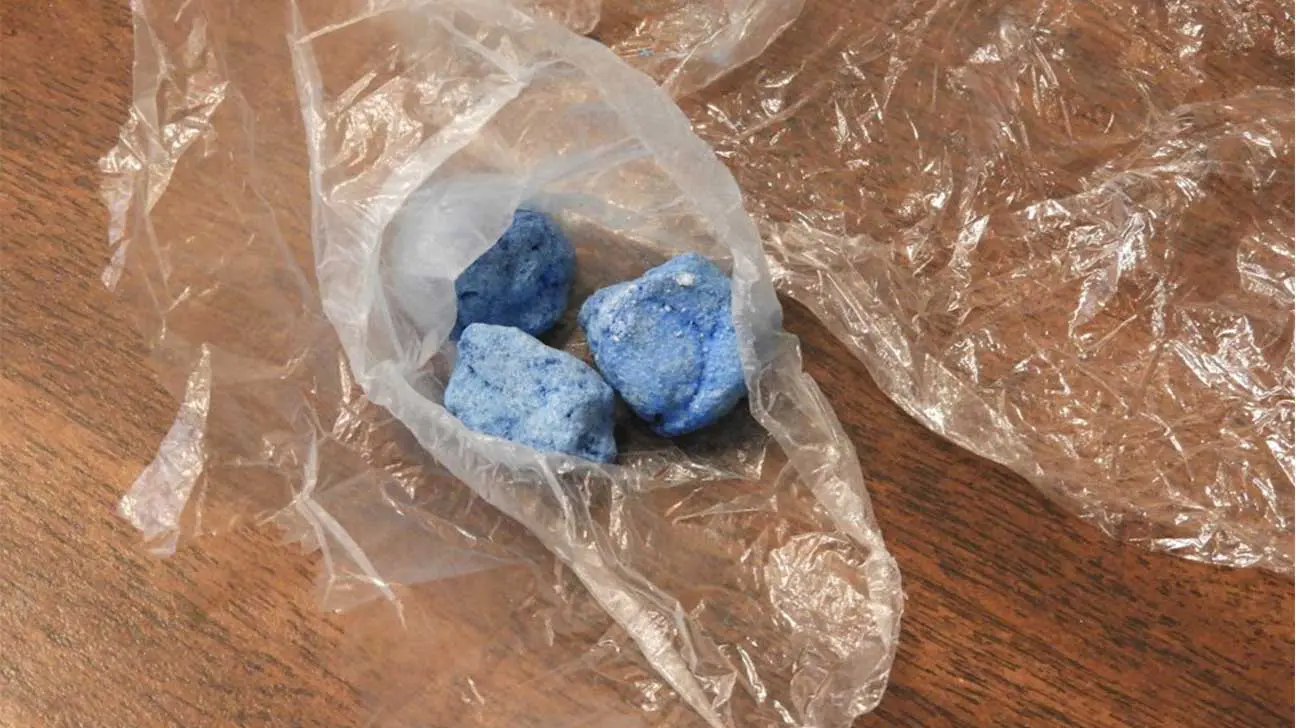
Blue heroin is marketed on the street as a more potent form of heroin than the powder from Asia or South America.
A derivative of “scramble” heroin of the early 2000s, blue heroin in North America generally contains the synthetic opioid fentanyl.
Why Is Blue Heroin Dangerous?
Blue heroin creates an especially high risk of heroin overdose because of the varied levels of fentanyl in it.
The fentanyl additive to blue heroin is between 50 and 100 times stronger than morphine and works on opioid receptors in the brain as a strong central nervous system depressant and analgesic.
Fentanyl in particular is dangerous because of the low dosage needed to cause an overdose.
People that might typically use black tar heroin or pure white powder heroin can easily overdose due to the dangerous potency and poor quality control.
Law enforcement noted that heroin users along the northeastern coast south of New York have experienced a higher instance of deadly opioid overdose with the increase of fentanyl-laced heroin available.
How Is Blue Heroin Abused?
Blue heroin is typically smoked, snorted, or mixed into a solution and injected. People that ingest this drug will feel effects within seconds of ingestion.
Short-Term Effects Of Blue Heroin
In addition to general feelings of euphoria, happiness, and the floating high, people that take heroin laced with fentanyl can experience severe side effects.
These are largely due to the central nervous system depression caused by blue heroin.
Some short term effects of heroin mixed with fentanyl include:
- unconsciousness
- slowed heart rate
- low blood pressure
- slowed breathing
- pinpoint pupils
- drowsiness
- tight feeling in the throat
- nausea
- confusion
- sedation
- difficulty concentrating
- weakness
- slurred speech
- sweating
- flushing
- stiff or rigid muscles
- heavy feeling arms and legs
- dry mouth
Long-Term Effects Of Blue Heroin
Sustained periods of heroin and fentanyl abuse can impact vital systems like the heart and lungs.
People that engage in any form of heroin drug use increase their likelihood of behavioral health issues, serious physical damage, and the risk of dependence, addiction, and deadly overdose.
Some effects of heroin and fentanyl after periods of intense or prolonged use include:
- heart attack
- stroke
- low blood pressure
- weakened heart valves
- irregular heartbeat
- increased sensitivity to pain
- increased risk of cancers and infections
- kidney damage
- liver damage
- constipation
- memory loss
- irritability
- chronic depression
Blue Heroin Drug Use Increases Risk Of Overdose
A person that takes blue heroin cannot know the strength or quality of the drug taken. Overdose deaths and severe drug overdose effects have been noted due to blue heroin use.
Like other opioid overdoses, the effects of a deadly blue heroin overdose can be reversed with timely administration of naloxone (Narcan).
People that have overdosed on blue heroin experienced some of the following symptoms:
- slow or labored breathing
- dangerously slowed heart rate and blood pressure
- coma
- extreme drowsiness
- cold or clammy skin
- unresponsive pinpoint pupils
- agitation
Blue Heroin Withdrawal
When combined, fentanyl and heroin in a combination like blue heroin can be very difficult to stop.
After 6-12 hours after their last dose, withdrawals can happen. Withdrawals peak after a day or two and can last up to a week.
With strong opioids, withdrawal symptoms can be dangerous to undergo without a medically supervised taper.
A person that takes street-level opioids like blue heroin can experience varied withdrawal symptoms that may require tapering and pharmaceutical interventions.
General withdrawal symptoms of heroin and fentanyl can include:
- increased blood pressure and heart rate
- irritability
- severe cravings
- cold flashes with goosebumps
- uncontrollable leg movements
- depression
- insomnia
- flushing and chills
- nausea, vomiting, and diarrhea
- general weakness
- muscle and bone pain
Getting Help For Blue Heroin Addiction
Whether you or a family member is abusing prescription opioid painkillers or unstable street-mixed heroin, it’s time to get help now.
Substance abuse and dependence of any kind is difficult to stop — especially during times of isolation during coronavirus (COVID-19) precautions.
To get help with heroin use and dependence, call our treatment specialists today.
We can provide information about supervised inpatient detox and treatment, and outpatient behavioral therapy to help you maintain healthy thought patterns and stay sober.
Call today to take your first steps towards a safer, healthier life.
Addiction Resource aims to provide only the most current, accurate information in regards to addiction and addiction treatment, which means we only reference the most credible sources available.
These include peer-reviewed journals, government entities and academic institutions, and leaders in addiction healthcare and advocacy. Learn more about how we safeguard our content by viewing our editorial policy.
- Centers For Disease Control And Prevention (CDC) — Fentanyl Overdose
https://www.cdc.gov/drugoverdose/opioids/fentanyl.html - Centers For Disease Control And Prevention (CDC) — Heroin Overdose
https://www.cdc.gov/drugoverdose/opioids/heroin.html - Drug Enforcement Administration (DEA) — Ohio Men Plead Guilty To Selling “Blue Drop” Heroin Mixed With Fentanyl That Resulted In Death
https://www.dea.gov/press-releases/2016/03/28/ohio-men-plead-guilty-selling-blue-drop-heroin-mixed-fentanyl-resulted - Journal Of Psychoactive Drugs — Sold As Heroin: Perceptions and Use of an Evolving Drug in Baltimore, MD
https://www.ncbi.nlm.nih.gov/pmc/articles/PMC6114137/ - Washington Post — How a mysterious synthetic drug is making heroin even more deadly
https://www.washingtonpost.com/news/post-nation/wp/2015/09/29/how-a-mysterious-synthetic-drug-is-making-heroin-even-more-deadly/


